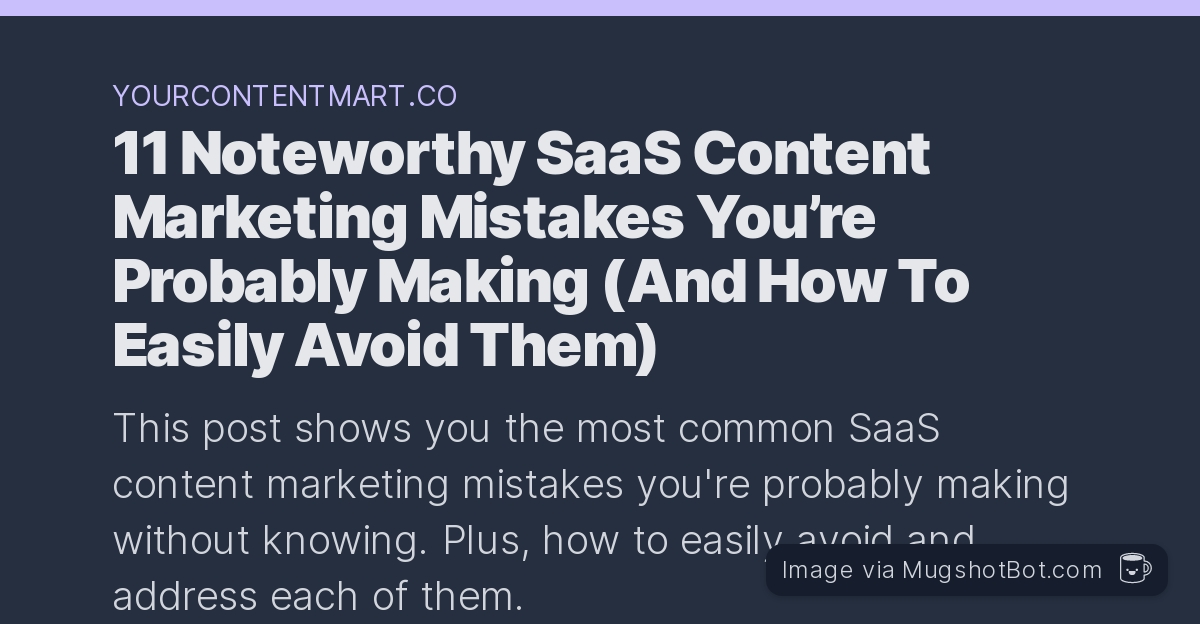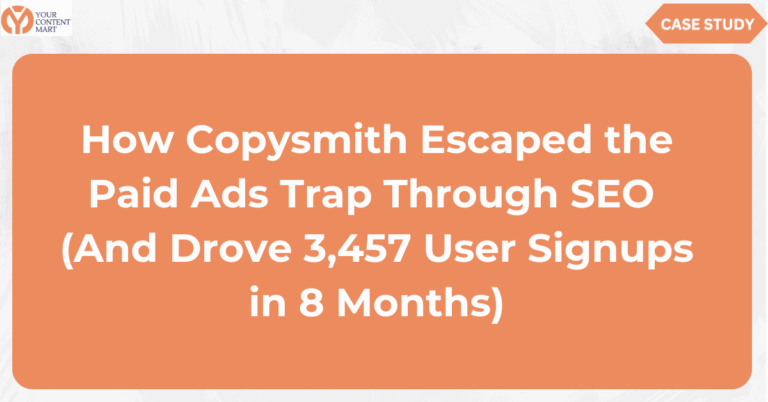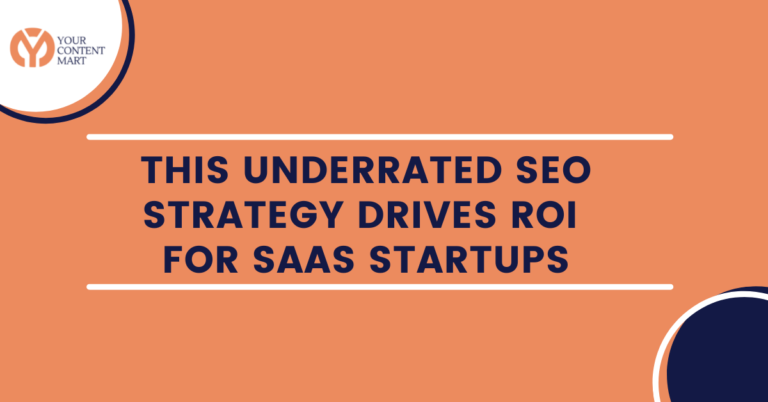I recently conducted a fun experiment on Indie Hackers.
And it panned out to become a huge learning process for me.
Here is what I did…
I offered to do a free content audit for SaaS companies that want to grow their business using content marketing.
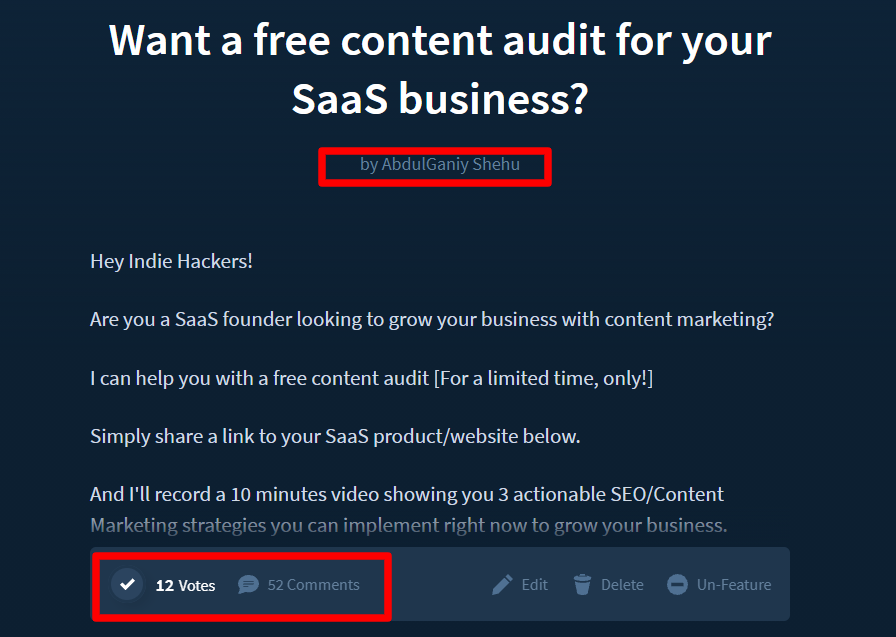
And guess what?
I got bombarded with requests from different SaaS founders, which eventually made me busy for some days.
My major reason for doing this was to know the challenges that my target audience is facing and to have a better understanding of how to serve them better.
In the long run, I got more than I bargained for.
In fact, the free content audit sessions gave me a first-hand experience of how most SaaS companies are currently running their content program.
Which is quite different from the numerous heresies and unverified claims that are being peddled around these days.
One of the most surprising things I discovered was that a lot of brands were making some common SaaS content marketing mistakes.
In most cases, these turned out to be a stumbling block in their quest to get better results from content marketing.
And to my utmost surprise, they were A LOT!
Not only that…
It was difficult to see any company that wasn’t falling into at least any of them.
So, I decided to write this post where I walk you through the 11 common content marketing mistakes of SaaS companies.
Plus, show you exactly how to address each of them.
That way, you can get better content marketing results for your SaaS brand.
Let’s get started…
TABLE OF CONTENTS
SaaS Content Marketing Mistakes You’re Probably Making Without Knowing (Backed by Research)
Below are 11 content marketing mistakes you’re most likely making as a SaaS company without knowing.
Let me outline them one after the other, plus show you exactly what you should be doing instead.
SaaS Content Marketing Mistake #1: Lack of Content Strategy
The most common content marketing mistake of SaaS companies is a lack of content strategy.
In most cases, I found out that companies were creating content without any strategy behind it.
How do I know this?
Simple.
I figured out that they lack focus with the kind of content they’re creating.
They could post about A today on their blog, and make a video about Z tomorrow on their YouTube channel.
Say, for instance, their SaaS is in the “AI copywriting niche”, they’ll spend time writing articles that are better served to developers.
Which makes you wonder why they’re investing in content marketing, in the first place.
Truth is…
Content marketing without a strategy is like building a house without a solid foundation.
What happens to the house in the long run?
It will collapse and won’t stand the test of time.
The same thing with content marketing.
If you don’t have a content strategy in your company, you’ll most likely not get any results from it.
I love the way, Erin Balsa, the Marketing Director at The Predictive Index puts it in this LinkedIn post:
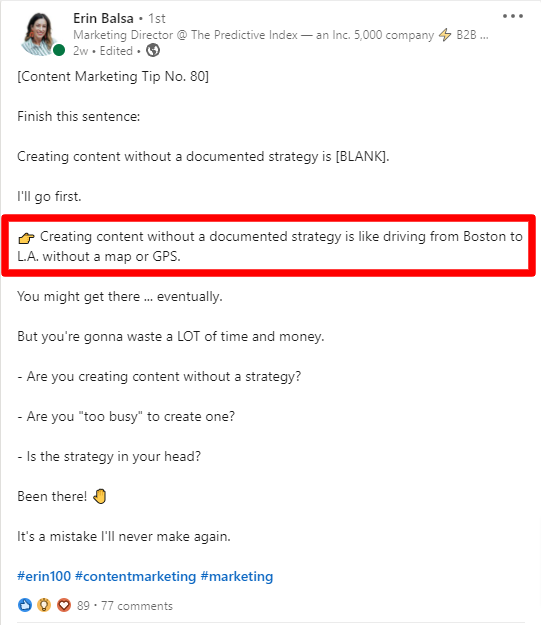
Indeed, creating content without any strategy behind it isn’t just about getting to your destination or not. You might get there eventually, but it will take a lot of time, effort, and resources.
Below are some of the things you stand to gain by having a documented content strategy for your SaaS company:
- Understand the goals you want to achieve with your content marketing program
- Know exactly who you’re creating content for
- Identify what the pain points of your audience are
- Know the kind of content that fits each buyer’s journey of your customers
- Figure out how to distribute the content strategically to reach your target audience
- Measure your results at the end of the day.
How Can You Address This Common SaaS Content Marketing Mistake?
It’s pretty simple and straightforward. Before implementing content marketing for your company make sure you create a content strategy. That way, you can better answer the why, what, how, who, and when of your content marketing plans.
If you’re hiring a content marketing agency or freelancer to create content for you, make sure you share the overall strategy of your company with them.
SaaS Content Marketing Mistake #2: Lack of Proper Keyword Research
If SEO is one of your distribution channels, performing proper keyword research before creating any piece of content is a MUST.
The reason is simple…
With SEO, you want your target audience to discover your content through the search engines, especially Google.
Hence, you should focus on creating content that targets specific keywords they’re searching for.
Else, you’ll end up creating content that no one will discover via search.
And in the long run, you won’t get the desired results from your investment in content marketing.
But guess what?
A lot of SaaS companies create content pieces they want to rank on Google, without performing any thorough keyword research before doing so.
Doing this is a recipe for failure.
Unless you’re creating opinionated content pieces, you must always conduct appropriate keyword research.
If you don’t, you won’t get any traffic from Google, no matter how hard you try, as succinctly put by Ahrefs CMO, Tim Soulo.

Contrary to popular opinion, conducting keyword research for your SaaS company is actually much easier than you think.
The first thing you must do is to identify the main topics and themes that your audience is interested in and searching for.
Once you’ve figured that out, the next thing is to plug that main topic or keyword into Google.
By doing this, Google auto-suggest will show you the exact keywords that people are searching for related to this topic.
And you can take things up from there.
Here is a quick example.
Let’s say your customers want to identify the customer journey of their users.
By searching for the main topic “customer journey” on Google, here are some auto-suggested keywords.
- Customer journey map
- Customer journey stages
- Customer journey in digital marketing
And so on.
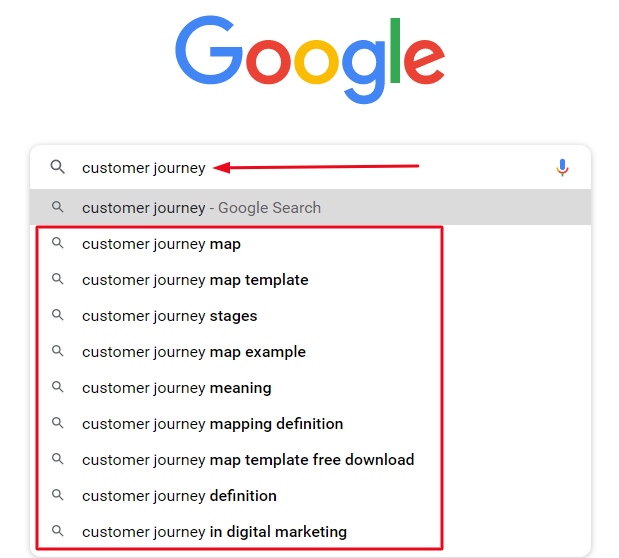
That’s not all…
You can take it a step further by adding the preposition “for” after it. Once you do that, here are the newly auto-suggested keywords.
- Customer journey for SaaS
- Customer journey for B2B
- Customer journey for ecommerce
- Customer journey for an app
And so on.
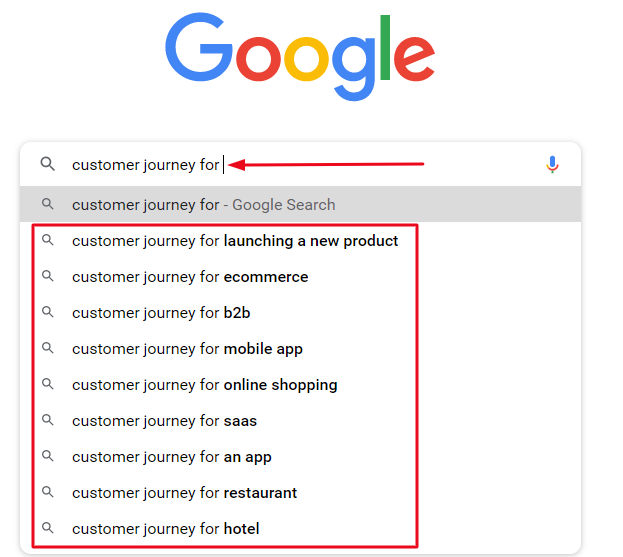
And guess what?
All these are potential keywords you can go after and rank for on Google.
While keyword research doesn’t end here. It’s a good place to start, especially if you’re a new startup.
And if you perform keyword research before creating any piece of content, you’re sure to get results in most cases.
Other keyword research tools you can use for this purpose include:
- Google Keyword Planner
- Keywords Everywhere
- Ubersuggest
- Ahrefs
- SEMrush
- Moz
How Can You Address This Common SaaS Content Marketing Mistake?
Before creating any piece of content, ask yourself this question:
“Is anyone searching for or will likely search for this keyword on Google”.
If your answer is Yes, then you can proceed to write and publish that article. However, if it’s a “No”, it means that you still have a long way to go, and you should go back to perform keyword research.
Once you’ve performed keyword research, the identified keywords should be the starting point for any piece of content you create.
SaaS Content Marketing Mistake #3: Tiny Content Portfolio
Earlier this year, HubSpot crossed the 100,000 customers mark and $1 billion in ARR respectively.
For a company that was founded over 15 years ago, that’s an impressive feat.
Most people focus on how HubSpot has an outstanding content moat, but don’t talk about the volume of content they published on their blog to get there.
The last time I checked, the HubSpot blog had over 13,857 pages that are indexed on Google, according to Semrush.

This means that on average, they publish about 923 articles on the blog every year.
This translates to about 2-3 articles every single day.
Here is a fact…
The more content you have on your website, the better your chances of getting results from content marketing.
While it’s possible to get results with a tiny content portfolio, this is very rare.
To see a lift in your content marketing results, invest in creating high-quality content pieces on a consistent basis.
Creating content on your website today, and waiting for 3-6 months before publishing another one isn’t a viable strategy.
Nick Jordan, founder of Content Distribution believes that websites that publish more content, get better results in search.

If you’re just starting, I highly recommend that you publish at least one in-depth piece of content every single week.
When you do this consistently, you’ll gain the trust of your audience and also show the right signals to Google.
But if you publish infrequently, you won’t stay top of mind with your audience. Which will eventually make them less interested in learning from you.
That’s not all…
It will be difficult for you to show Google what your website stands for, which could hurt your rankings in the long run.
How Can You Address This Common SaaS Content Marketing Mistake?
Most companies fail to publish content consistently because they don’t have a specific schedule they follow.
So, they only publish a new content piece when it’s most comfortable for the founder or marketing leader to do so.
Doing this won’t help you in any way. Rather, you should create a content calendar that you follow religiously at your company.
Even if you’ll end up staying up late in the night to ensure that you hit and meet your publishing deadline, do it.
If possible, use project management tools like Google Sheets, Trello, Asana, Monday, ClickUp, etc. to manage your content operations.
SaaS Content Marketing Mistake #4: Insufficient Backlinks
Backlinks are uber-important in SEO.
Except you’re creating content with no intent to rank high on Google.
In that case, you might not need them.
While it’s possible to rank with little to no backlinks, it’s becoming harder to do so, especially in competitive niches.
In case you don’t know, backlinks are the currency of the internet.
More backlinks typically show that your company has more authority in the eyes of Google.
And the more authority your company is, the better your chances of ranking quickly for any piece of content you create.
Even if you rank without backlinks today, a bigger competitor can come into your niche tomorrow and dominate it, due to the high authority they have.
That said, a lot of SaaS companies underestimate how important backlinks are in their overall content/SEO strategy.
For something that can make or mar your content marketing program, that’s a costly oversight.
And as John-Henry Scherck, Principal Consultant at Growth Plays puts it:
“Link generation is core to ranking well in search. SEO is much easier if you have a strong brand that naturally generates backlinks”

How Can You Address This Common SaaS Content Marketing Mistake?
To acquire high-quality backlinks at scale, you should invest in earning (not building) backlinks for your website.
What’s the best way to do this?
Simple.
Leverage data-driven content.
When you publish data-driven content in your niche, other websites in your industry that use that information are more likely to link to you.
Some examples you can try out include:
- Statistics pages
- Surveys
- In-depth study
- Original research
SaaS Content Marketing Mistake #5: Search Intent Mismatch
When someone searches for any keyword on Google or other search engines, they’re doing so to satisfy specific search intent.
If you want Google to rank your content, make sure that it meets the search intent of your ideal target audience.
The reason is simple…
No one wants to spend time reading a piece of content that doesn’t answer their query satisfactorily.
In most cases, if they don’t find what they’re looking for after stumbling on your content, they will leave immediately.
The mistake most SaaS companies make is creating content they think their audience needs to read, and not what they actually want to read.
While this might work for content pieces that are not positioned to rank on search, it’ll fall flat for SEO-driven content.
Truth is…
When you meet the search intent, you make your readers happy. By extension, you’d get more love from Google (aka ranking position), all things being equal.
Brendan Hufford, the founder of Growth Sprints, recommends answering these four (4) questions to nail the search intent for any piece of content.
- Are they searching for a solution to a problem?
- Does the search phrasing include a possible solution?
- Does the search phrasing include your product?
- Do they already know your solution is best for them?
These questions can be further classified into:
- Problem Aware
- Solution Aware
- Product Aware
- Most Aware

How Can You Address This Common SaaS Content Marketing Mistake?
To make sure that you nail the search intent for any piece of content, here’s what you should do.
Before creating any piece of content, put yourself in the shoes of your future reader.
Ask yourself:
“When X types this query on Google, what exactly do they want to know?”
If you’re able to identify and answer that in your content piece, you’ll nail the search intent easily.
One hack you can use to figure out the search intent of your target keyword is to check the top 10 ranking pages on the SERPs.
Take a look at each of those pages one after the other, to see exactly what they’re covering.
This gives you an idea of where to start from and things you should include in your content piece as well.
SaaS Content Marketing Mistake #6: Lack of Proper On-page SEO
How do you tell Google the exact keyword(s) you’re targeting with a specific page on your website?
Simple.
By optimizing that page to target a specific keyword phrase or query.
Else, the Google bots won’t understand what your page is about and might end up not ranking it.
This is where on-page SEO comes in.
In case you don’t know what this means, it’s optimizing your content appropriately to show Google what you want it to rank for.
This is quite different from keyword stuffing, which a lot of people practice knowingly or unknowingly.
As important and straightforward as this is for creating a content piece that ranks on Google, a lot of SaaS companies don’t take it seriously.
And at the end of the day, they end up creating content that isn’t indexed on Google and wondering why that’s happening to them.
Listen to me…
- Do not be that SaaS company that doesn’t include relevant heading tags for your subheadings.
- Do not be that SaaS company that isn’t using the exact keyword you want to rank for in the slug URL.
- Do not be that SaaS company that has multiple H1s on a page, with no H2s – H4s.
Aaron Orendorff, the VP of Marketing at Common Thread Collective recently shared how his friend got ripped off by an “SEO writer”.
10 Warning Signs Your Content Writer or Agency Is Full of S*** 🧵
— Aaron Orendorff (@AaronOrendorff) September 23, 2021
Met with a friend yesterday, and it broke my heart to see their brand having been absolutely taken advantage of by an “SEO writer.” Here’s my best tips to save yourself from that fate …
Number 9 will shock you
Most of the mistakes identified in the thread were on-page SEO issues that should be a checklist that every writer and agency follows.
How Can You Address This Common SaaS Content Marketing Mistake?.
Keep these in mind before you publish that next piece of content on your SaaS blog:
- Including the main keyword in the H1 and title tag
- Including the main keyword and its variations in the H2 – H6 tags
- Sprinkling the main keyword and its variation naturally throughout the content
- Including the main keyword in the first 100 words or so of your content
- Adding an alt text with the keyword or its variation in the images
- Linking to relevant external sources from your content pieces
- Inter-linking between pages on your website.
- Making sure that the content is reader-friendly and easy to navigate.
By doing all these and many more, you’ll be able to tell Google the exact phrase you want to rank for, and it’ll do just that.
SaaS Content Marketing Mistake #7: Not Leveraging Pain-point Content
SaaS companies focus on creating content pieces that target high-volume keywords.
That way, they can rank for tons of keywords and generate tons of traffic, if everything goes fine.
While there’s nothing wrong with this approach.
The downside is that it doesn’t put into consideration one of the core reasons for investing in content marketing – to drive user signups and increase bottom-line revenue.
Ranking for multiple high-volume keywords is a vanity metric that shows that you’re doing something right SEO-wise.
That said, in most cases, it won’t help to drive conversions for your business, in any way.
For matured and growth-stage SaaS companies, they can get away with this. Since they have a huge marketing budget and have the time and resources to test things out.
If you’re an early-stage SaaS company, chasing high-volume keywords shouldn’t be the core of your content/SEO strategy.
What I recommend that you should do instead is to focus on creating pain-point content pieces and assets.
The reason for this is simple…
When you target pain-point keywords, you’re meeting the immediate need of your target audience.
That way, converting them from readers into buyers (customers) becomes much easier.
However, if you don’t create content that targets their pain points, it might take time before they convert into a paying customer.
How Can You Address This Common SaaS Content Marketing Mistake?
The first thing you must do is to identify the pain-point keywords to go after?
The easiest way to do that is to start by asking your customers or prospects questions.
When you do, you’ll discover a common trend in their responses, which shows you exactly what you need to focus on.
Alternatively, you can use your intuition and industry knowledge to figure out what your customers are most likely to have as pain points.
Take, for instance, if you have a big competitor in your niche, chances are that their current customers are looking for a better deal elsewhere.
So, creating a piece of content targeting [big competitor alternatives] will most likely solve a pain point your prospects have now.
Other pain-point types you can target include:
- You vs Competitor Y.
- Competitor X vs Competitor Y
- Best category software/tool
- Competitor X pricing [What does competitor X cost]
- [Use case] Templates
And so on.
Don’t sleep on pain-point content as a SaaS company. It can accelerate your company’s growth.
SaaS Content Marketing Mistake #8: Not Leveraging Product-led Content
Most people think that telling the reader about their product or use cases in a piece of content is promotional.
This is a huge mistake that a lot of SaaS companies make.
Here’s the reality of a typical reader in 2021 and beyond.
They want to know exactly how your SaaS product works even before signing up.
So, it’ll do you a lot of good if you actually show them.
This is what product-led content is all about.
Leveraging this content type is strategic because it helps you kill two birds, with one stone.
Dr. Fio Dossetto, the founder of Content Folks, mentioned that product-led content is preferred to the traditional blog types because it helps with acquisition and retention.
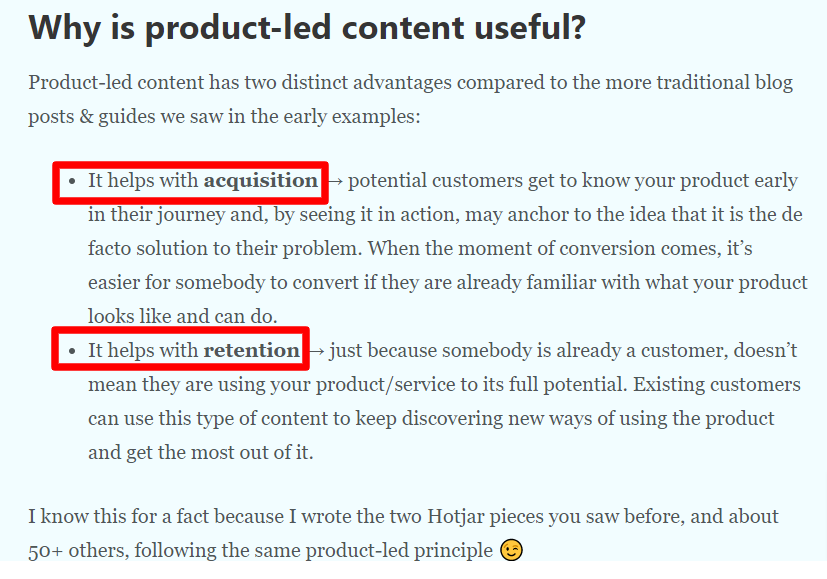
With product-led content, you’re able to educate and show your readers exactly what they should expect even before using your product.
Not only that, you can convert them into user signups directly from your content pieces.
And the best part…
If you have existing customers, this content type helps you to retain them better.
How Can You Address This Common SaaS Content Marketing Mistake?.
What you need to do here is simple.
See each piece of content you create as a strategic tool to tell your reader about your product.
That way, you don’t only educate them about the problems they have, but also show them how to solve them using your software.
While it’s easy to weave your product into some content pieces, it’s extremely hard in some cases.
And if SEO is your main growth/distribution channel, you might find it difficult to plug in your product naturally when targeting some keywords.
Your best bet is to identify those keywords where it’s easy to mention your product, and those where you can’t.
For keywords where you can mention your product, then you can start with those. For those, where you can’t, create content pieces for them afterward.
Also, you can target keywords with zero or low search volume, where it makes sense to plug in your product naturally.
The point here is…
If you aren’t leveraging product-led content as a SaaS company, you’re leaving so much on the table. Change that narrative today.
SaaS Content Marketing Mistake #9: Having Poor User Experience
When you visit some SaaS websites, you cringe at what you see.
This is because the founders or marketers over there think that we’re still in the early days of the internet.
This is a big mistake!
If you want to win at content marketing in 2021 and beyond, you must have a fast-loading and good-looking website.
If your website takes time to load, you’ll lose potential readers and customers.
And if your website is difficult to navigate, no one will read your content, as most visitors will bounce off.
That’s not all…
Google is now focusing on the user experience of visitors to your website. With the introduction of core web vitals, user experience is becoming more important than ever.
If readers leave your website immediately after finding it through search, it could signal to Google that your content piece isn’t helpful to the reader.
Hence leading to the loss of your current ranking spot in the search engine.
While it’s still early days, this is something you must keep in mind and take seriously to get the best results from content marketing.
How Can You Address This Common SaaS Content Marketing Mistake?.
Pay close attention to the design and page speed of your website.
Before publishing any piece of content, make sure that you break your written text into smaller chunks and add visual elements like custom images, infographics, screenshots, GIFs, videos, and so on to make it an enjoyable read for your visitors.
SaaS Content Marketing Mistake #10: Having Technical SEO Issues
Technical SEO issues can break your website’s performance on Google and other search engines.
While it’s easy to discard them as unnecessary, it could alter your content marketing success.
One company I audited recently, had issues with the canonicalization of their pages.
Due to this, most of their pages weren’t appropriately indexed on Google.
Make sure you resolve any of the technical issues you have on your website before it’s too late.
How Can You Address This Common SaaS Content Marketing Mistake?
Reach out to a technical SEO consultant to audit your website for any technical issues. Whenever you discover any of them, make sure you fix them immediately.
You can also use SEO tools like Screaming Frog, DeepCrawl, Content King, Sitebulb, Ahrefs, and so on to perform a technical SEO audit of your website
SaaS Content Marketing Mistake #11: Not Promoting/ Distributing Content
Blogging and praying is still popular among most SaaS companies. In most cases, they spend time and resources producing a piece of content and do not promote or distribute it afterward.
This leads to having tons of valuable and helpful content pieces on your website that no one is reading, or even knows that it exists.
This is a pitfall you must avoid as a SaaS company.
As you spend time creating that amazing piece of content, do the same with distributing it to your target audience as well.
How Can You Address This Common SaaS Content Marketing Mistake?.
Follow the mantra of Ross Simmonds, the founder and CEO of Foundation Marketing, which goes thus: “Create Once and Distribute Forever”
Remember that any piece of content you create is an invaluable asset for your business. Distribute it strategically, so that your target audience can discover it.
This content distribution checklist video below by Ross will help you to promote your content pieces better.
Final Thoughts: Avoid These CringeWorthy Mistakes and Get Better Results From Your SaaS Content Marketing Efforts
If you’re a SaaS business owner, chances are that you’re making any or all of the mistakes outlined in this post.
As you’ve likely found out, these mistakes have a huge impact on your traffic, revenue, and the results you eventually get from your investment in content marketing.
As a SaaS content marketing agency, we make sure that our clients do not make any of these mistakes.
If you’d like us to help with your SaaS content marketing strategy, click on this link to get a free content analysis from our lead content strategist.
You can as well join our newsletter, SaaS Growth Bites, below to receive exclusive insights and tips every Thursday, on the best way to grow a SaaS business using content marketing.

